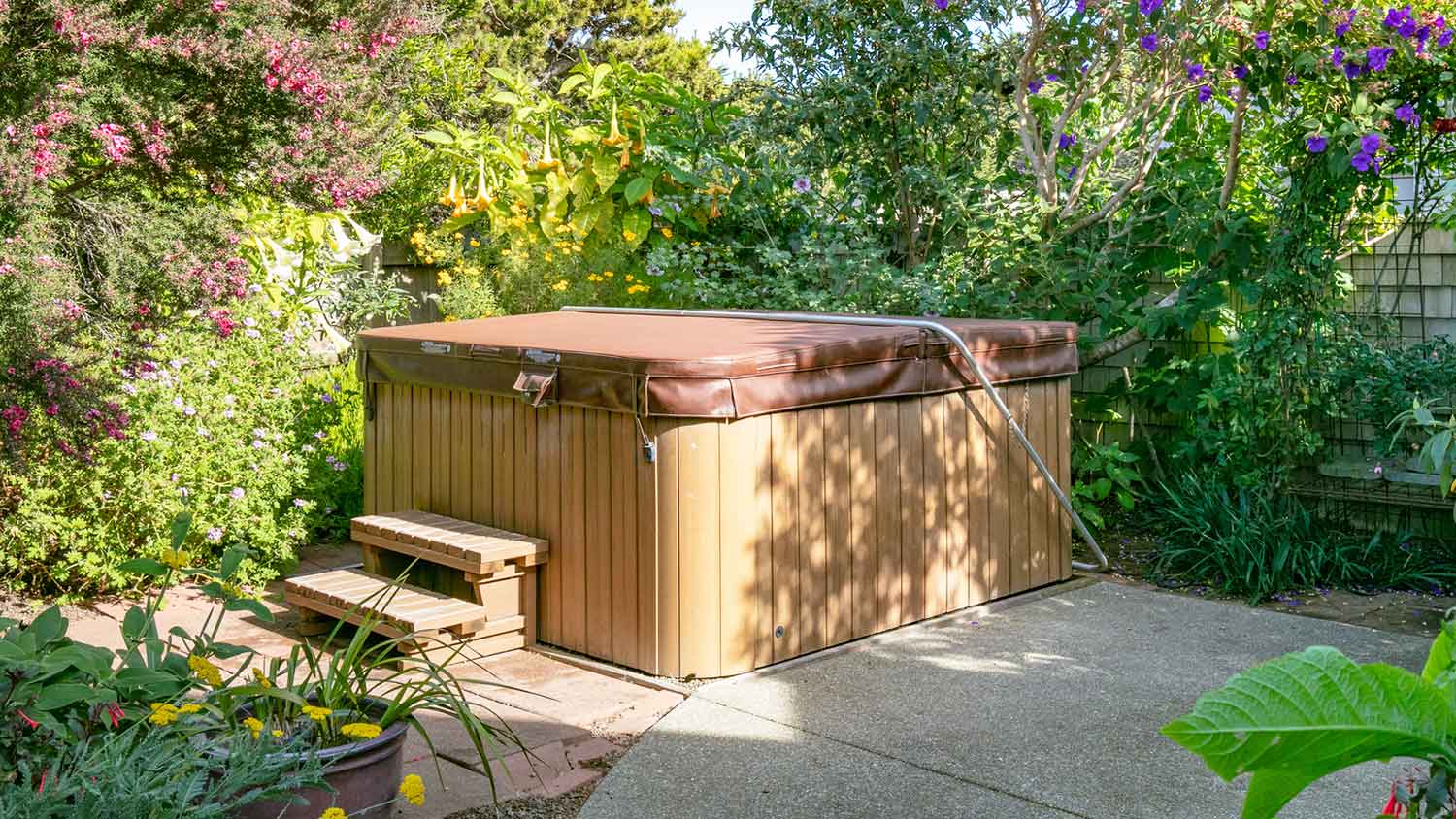How to Build a Deck Around a Pool: Tools, Supplies, and Step-by-Step Instructions
Make a big splash with this backyard DIY


- Reciprocating saw
- Circular/miter saw
- Jigsaw
- Power screwdriver
- Tape measure
- Pressure-treated lumber
- 4x4 deck posts
- 4x4 precut railing posts
- 2x6 rim joists
- 2x6 floor joists
The sun is shining, your friends are jumping in the water, and you're grilling hot dogs—welcome to life with your beautiful new pool deck. With the right lumber, hardware, and tools, you can build a pool deck that enhances the comfort and luxury of your outdoor space. Dive into how to build a deck around a pool with our step-by-step guide.
Plan Your Deck
 Photo: sbw19 / Adobe Stock
Photo: sbw19 / Adobe StockTo help determine the dimensions for your deck, measure your pool's diameter, length, and height. Create a rough drawing of your deck, including the dimensions. You can also consider buying a pre-made deck plan, which usually comes with construction plans, lumber, hardware, footings, and deck boards.
Apply for a Permit
Depending on your local municipality, you may need a permit to build a deck. Review any guidelines for residential pool decks in your area to ensure you meet the code for stairs, handrails, and other elements. Most states require you to install some type of pool fence to ensure no one enters without supervision.
Mark the Perimeter and Post Locations
Using wood stakes and mason line string, outline the perimeter of your deck.
Adjust the markers until they are level. With paint, mark where you want to install your deck posts. Plan your post locations based on the following guidelines:
Your interior posts near the pool should be 1 foot from the edge of the pool.
Your posts should be four to six feet apart when using 4x4 deck posts.
Clear and Level the Area
 Photo: Jo Ann Snover / Adobe Stock
Photo: Jo Ann Snover / Adobe StockDig out any bushes that are inside your deck’s area. While your ground doesn't need to be completely level, aim to make it relatively even and flatten out any ground with a shovel or tamp/leveling tool.
Set Your Posts
Place your concrete deck blocks in the locations you marked. The pier should be level in both directions. Adjust the ground with a shovel to level it out if needed.
Set your 4x4 deck posts into the square sockets of the deck blocks nearest to the pool. With a level and pencil, mark a line on your 4x4s for the height that lines up flush with the pool's edge. Depending on your ground sloping, the line on each post might vary slightly.
Remove the posts and measure down from each line, accounting for the pool's coping, your floor joist height (5 1/2 inches when using 2x6s), and deck board thickness (1 1/2 inch when using 2x6s), along with 1/2 inch for expansion. Cut your posts to length and set them back on the concrete blocks.
On the outside perimeter of your deck, cut your posts in line with the others (use a chalk line to get it level), or use taller posts there to support your railing.
Cut and Install Your Rim Joists
 Photo: Tyler Olson / Adobe Stock
Photo: Tyler Olson / Adobe StockCut 2x6s to create the perimeter joists of your deck. Place them alongside your deck posts and ensure they're level (best if you have a partner to help you). Screw the joists in place at the height you marked. At the corners, square the two pieces of wood to make a 90-degree angle. Screw them in place with an angle bracket, ensuring first that your joist is level. Consider adding an extra beam joist in the center of a large deck.
Add Diagonal Braces
If your deck is 24 inches or higher above grade, install 2x4 diagonal braces to add strength to your joists and posts. The braces should run between the posts from interior to exterior and parallel to the pool. Use through bolts and lag screws to secure them in place.
Install Floor Joists
The floor joists of your deck should run 16 inches apart (from each joist’s center) across the deck. Cut your 2x6 joists to span the width of your deck and fit between the rim joists. Screw in joist hangers, set the joist, then screw the joist in place, ensuring that each joist remains level. Consider adding block joists between your floor joists for extra stability, especially if you’re building a large deck.
Lay the Deck Boards
 Photo: goodluz / Adobe Stock
Photo: goodluz / Adobe StockPlace your 2x6 decking across your joists, crown side up. Use 1/4-inch or 3/8-inch spacers between your decking boards to allow for drainage and expansion of the wood.
For the deck boards closest to the pool, cut the edges with a jigsaw. The gap between your above ground pool and deck should be 1/2 inch to allow for expansion of the wood. If you cut 80-degree angled ends, the boards can slide under your deck's coping and form a curved shape that follows the line of your pool.
Secure each deck board to the joists with 2 1/2 inch deck screws. If any deck boards overhang the perimeter of the deck, use a chalk line to mark the location of the outer joist. Use a circular saw to trim the edges to be flush with the perimeter joists.
Secure the Railing Posts
Install 4x4 precut railing posts every six to eight feet, aligning with where your floor joists and rim joists come together, so you can properly secure the railing post. Measure the width of your stairs and leave an opening.
With a power screwdriver and lag screws, install your railing posts around the perimeter of the deck. Most precut posts have a notch at the base to fit against the edge of the deck.
Build the Handrail
Make horizontal handrails that span between the railing posts by cutting a 10-degree bevel on the ends of a 2x6. Slide the board between the two posts and fasten the handrail with 2 1/2-inch deck screws. Cut a 2x4 of the same length and screw it to the top of the 2x6 rail to act as a decorative cap. Sand the edges smooth.
Attach the Balusters
Hold your balusters upright and parallel with the railing posts. Use a level to ensure each one is straight. Your balusters should be approximately 4 inches apart, measuring from the center of the balusters. The beveled ends of the balusters should be pointed down and facing out. Screw the balusters to the railing and rim joist.
Construct the Stairs
 Photo: Myra / Adobe Stock
Photo: Myra / Adobe StockYour beautiful new deck needs a pathway to the ground: it’s time to build deck stairs.
Most stair treads need to be 36 inches wide to meet local code, but you can make your staircase wider if you want. You need one stringer for every two feet of stair width. If your stairs are 36 inches wide, you need three stringers: a left, a right, and a center.
Using precut stair stringers, set the bottom ends on concrete patio blocks to avoid ground moisture coming into contact with the wood. Make sure the stringers are level. Screw the upper ends of the stringers to the bottom joist of your deck, and screw an angle bracket to each side of the stringer.
Cut stair treads out of 2x12s, then screw them to the stringers. Build a railing for your stairs the same way you built the guardrails on your deck with a sloping angle that matches the stairs.
Connect the Gate
To prevent young children and pets from being in the pool unsupervised, build a gate with a latch and lock. Cut a frame for your gate out of 2x4s, making 45-degree angled cuts, as if constructing a picture frame. Square the corners and screw them together with flat angle brackets. Secure balusters to the frame, the same distance apart that you chose for your railing balusters.
Attach your gate hardware and line it up with the lock to ensure it moves easily and latches in place. Face your gate so it opens to the pool, not to the stairs.
Stain the Deck
 Photo: KOTO / Adobe Stock
Photo: KOTO / Adobe StockWait 30 to 60 days after constructing a new deck to stain your deck. Wood needs time to “age” and dry first. Stain your deck to ensure it holds up to weather and UV rays.
Allow the stain to fully cure before adding your furniture, grill, and other fun outdoor accessories.
Tips for Taking Care of Your Pool Deck
With a gorgeous new deck, you'll want to maintain the space for years of splashing. Here’s how to take care of your pool deck:
Reseal your deck every one to three years to ensure it holds up to the elements.
Clean your deck at least once a year, including sweeping off debris, dirt, leaves, and snow.
Move your pool furniture and other accessories on occasion to avoid uneven fading.
Trim bushes to be at least 1 foot away from your deck to avoid moisture damage.
Secure any loose boards or screws as soon as you notice them. Replace faulty boards and screws.
DIY vs. Hiring a Pro
If you’re confident with a jigsaw and power screwdriver, building a deck for your pool is a rewarding DIY that can save you thousands on labor. But you’ll need plenty of patience and time and all the right tools to ensure your deck is sturdy, level, and built to last.
If you’d rather not give up several free weekends, don’t own the right equipment, or don’t have the ability or confidence to complete the project, hire a local deck builder. They’ll ensure your deck is level, durable, and meets all building codes.
C.E. Larusso contributed to this piece.
Frequently Asked Questions
There are several perks to building a deck around your inground or above-ground pool. Specifically, building a deck around a pool gives you space to lounge and sunbathe, easy access to monitor kids in the pool, extra room for entertaining and dining, an anti-slip surface for post-pool fun, and enhanced aesthetics.
The cost to build a deck around a pool typically ranges from $3,000 to $12,000, depending on the size, material, and whether you tackle the build yourself. Most people pay an average of $5,000 for their pool deck project. Hiring a pro to build a pool will cost you more for labor, but it will be worth it to ensure a safe and secure installation.
Yes, you can build a pool deck yourself, but it takes precision, a lot of time, and many specific tools. You’ll need to create a deck plan, be careful with measurements, cut each piece of wood, secure the pieces properly, and ensure the deck meets building codes. Building a deck around a pool is a rewarding DIY, but it’s time- and labor-intensive, so thoughtfully consider your abilities and the time you have before embarking on this DIY.
The least expensive way to build a pool deck is with concrete deck blocks, pressure-treated lumber, and the appropriate hardware for hanging joists and securing deck boards. With these basic yet durable deck materials, you'll have a pool deck that's built to last without the high price tag. You should also stain or seal the deck to protect it against the elements.
An above-ground pool with a deck can increase your home's value by as much as 4% to 7%, but it depends on your local climate, potential buyers, and the size and condition of your pool. Some buyers see a pool as a liability instead of a luxury, especially if it's at the end of its life span. In general, it's best to add a pool and deck to your property if it will bring you enjoyment—not because it raises the value of your home.














